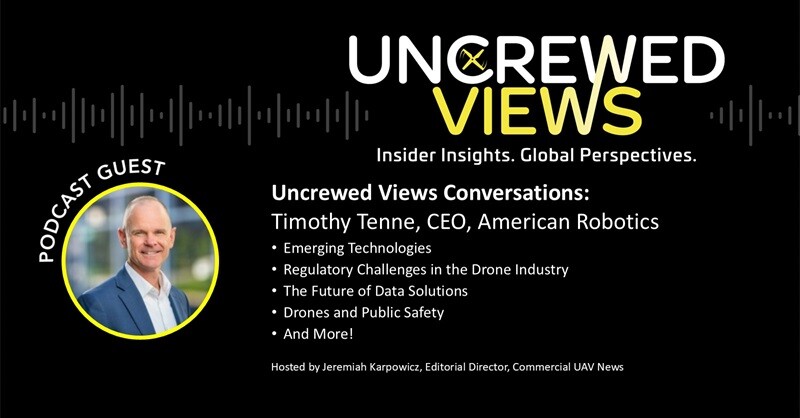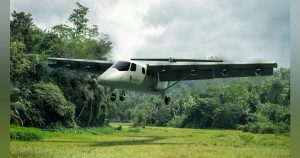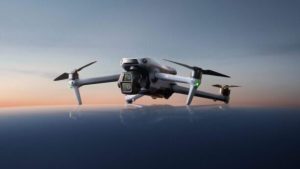Podcast Spotlight: In Conversation with Timothy Tenne, CEO of American Robotics
Picture a scenario where drones silently execute their missions over expansive fields, industrial centers, or along vital railways—gathering vast data sets without a pilot’s presence. For Timothy Tenne, CEO of American Robotics, this vision is more than just a dream; it’s the core of his mission and was the focal point of a recent Commercial UAV News podcast interview.
This detailed guide examines Timothy Tenne’s career journey, American Robotics’ groundbreaking technologies, regulatory developments, and the future direction of autonomous drone solutions—uniting expert opinions, case examples, and shared industry insights.
Meet Timothy Tenne: The Mind Behind Autonomous Drones
Timothy Tenne’s path to leadership at American Robotics reads like a modern aviator’s tale. A U.S. Naval Academy graduate with expertise in economics, engineering, and law, Tenne holds numerous advanced degrees and certifications, including a Juris Doctor and extensive aviation credentials.
- Early Career: Navy and commercial pilot with over 15,000 flight hours globally.
- Key Positions: FAA roles in aviation safety and drone integration.
- Leadership: Work at Nordic Unmanned and Easy Aerial.
- Academia: Law professor and regulatory policy influencer.
This broad range of technical, operational, and policy skills makes Tenne an exceptional bridge between innovation and regulatory frameworks.
American Robotics: Empowering Drones with Autonomy
What distinguishes American Robotics in the competitive drone technology landscape? Simply put, full automation.
Core Innovation:
Recognized for developing the first FAA-approved, fully automated commercial drone system, American Robotics offers a drone-in-a-box solution—akin to a “Roomba for the skies,” as Tenne humorously describes—which can autonomously launch, navigate, gather data, and recharge with minimal human input.
Key Features:
- High-resolution airborne data acquisition.
- Unattended, round-the-clock operations for enterprise clients.
- Utilization of robotic autonomy, AI, machine vision, and edge computing.
- Engineered for sectors like oil & gas, railways, mining, agriculture, and vital infrastructure.
Impact is tangible as their drones perform regular perimeter checks, infrastructure evaluations, and environmental assessments—providing critical, real-time insights to managers.
“People don’t want a drone; they want automated data solutions… What they care about is reliability, accuracy, and timeliness,” says Tenne.
Regulatory Pioneering: Beyond Visual Line of Sight (BVLOS) and FAA Rules
U.S. regulations have posed challenges for most drone companies, especially the rule that drones must remain within the pilot’s sight. This limitation complicates large-scale, economical autonomous operations—unless an FAA waiver is granted.
American Robotics’ Milestone:
They were trailblazers in obtaining the pivotal FAA BVLOS waiver, authorizing their systems for autonomous operations beyond the operator’s sight in Massachusetts and beyond.
Tenne’s expertise is invaluable here: As a former FAA official instrumental in developing Part 107, he’s strategically placed to influence and adapt to the regulatory terrain. He often emphasizes integrating drones into the national airspace system as aircraft, demanding equivalent safety and training protocols.
Hot Topic: International Perspectives
Tenne advocates learning from Transport Canada’s BVLOS guidelines, emphasizing collaborative industry pilots and innovative frameworks balancing progress and safety.
“We had an industry that felt they were making hammers and screwdrivers in most instances, but it’s an aircraft… It all happens in the National Airspace System,” asserts Tenne.
Industry Applications: Where Drones Deliver Real Value
Together with Ondas Networks and Airobotics, American Robotics is targeting sectors where dependable, automated data solutions offer transformative potential:
- Oil & Gas:Pipeline oversight, leak spotting, and safety evaluations.
- Rail:Track inspections, security surveillance, and asset management.
- Mining & Agriculture: Crop monitoring, resource analysis, and ecological safety.
- Public Safety & Critical Infrastructure: Real-time intelligence for first responders and crisis management.
By eliminating the need for onsite pilots and enabling continuous operations, their systems considerably reduce costs, enhance safety, and accelerate decision-making—a compelling case for automation.
Case Study: Why Baltimore? A New Hub for Autonomous Flight
In 2024, American Robotics opened a branch in Baltimore, increasingly recognized as a drone technology and research nexus. Maryland’s proximity to government and defense groups, a skilled talent pool, and engaged academic partnerships make it an advantageous location.
A notable detail: The University of Maryland spearheads drone research, comprising a southern Maryland test site and an autonomous vehicle hub at Salisbury-Ocean City Airport. With profound regional and regulatory insight, Tenne identified this step as logical for expanding American Robotics’ influence and forging new alliances.
The Human Side: A Team Built on Expertise and Vision
What inspires confidence in American Robotics under Timothy Tenne? Beyond technical prowess, it’s their commitment to collaboration, education, and safety:
- Leadership leverages experiences from military, commercial aviation, regulatory bodies, and entrepreneurial initiatives.
- They contribute to industry bodies (AUVSI), regulatory panels, and global workgroups.
- Beyond selling drones, they partner to yield data-driven solutions that resolve tangible business challenges and optimize ROI.
Clients and partners perceive American Robotics as “a team making the skies safer and smarter—one automated mission at a time.”
Expert Tips: What to Consider When Exploring Drone Automation
For Business Clients:
- Identify the data requirements and desired delivery speed.
- Ensure compliance— verify FAA BVLOS waiver possession.
- Seek actual autonomy over systems needing remote pilots to avoid hidden costs.
- Emphasize cybersecurity and data protection, especially in vital infrastructure areas.
For Drone Enthusiasts and Startups:
- Stay updated on BVLOS regulations as policies evolve swiftly.
- Pursue certification and training for cutting-edge operations.
- Engage with industry groups and participate in panels, like those led by Tenne, for the latest advancements.
For Policy Leaders:
- Collaborate on pilot protocols for safety and efficiency.
- Examine global examples, such as Canada’s, to harmonize innovation and public safety.
- Acknowledge drones as aircraft requiring rigorous standards of training and integration.
Looking Ahead: What’s Next for Automated Drones?
According to Timothy Tenne, drones will ultimately become as commonplace and unobtrusive as Wi-Fi routers or security cameras, delivering insights discreetly to drive informed decisions.
“Full autonomy is crucial for attracting customers. They want information, not just a flying robot,” emphasizes Tenne.
As the sector progresses—with enhanced connectivity, smarter AI, and refined regulations—expect drones to solidify their roles in agriculture, industry, smart cities, and emergency response.
Final Thoughts: Trust, Progress, and the Art of the Possible
American Robotics and Timothy Tenne epitomize the blend of expertise, regulatory acumen, and a passion for innovation. Their narrative conveys that the essence of drones resides in the smooth, dependable data flow that influences our environment.
For those contemplating drone integration into business operations or seeking to understand the evolving aerial data landscape, American Robotics—and leaders like Timothy Tenne—offer valuable insights into future trends.
*Engage with industry panels, connect with American Robotics, or stay informed on drone regulations for further insights into this dynamic sector.*













